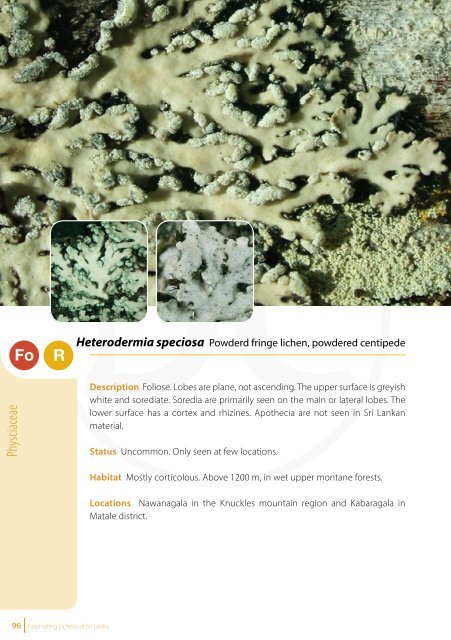You also want an ePaper? Increase the reach of your titles
YUMPU automatically turns print PDFs into web optimized ePapers that Google loves.
Hypogymnia<br />
Tube lichens, bone lichens, pillow lichens<br />
Lecanorales Parmeliaceae<br />
45<br />
Hypogymnia is widely distributed throughout both hemispheres. It is most<br />
common all over Europe, Asia, Africa, Australia, and North America, and<br />
particularly in countries such as Japan and New Zealand. Most <strong>of</strong> the species<br />
are epiphytes on bark and twigs. Some species are found on rocks, dead wood<br />
and sometimes on soil in cool to cold areas in well lit, exposed habitats in high<br />
altitudes. Most species are mainly confined to the canopy and upper branches<br />
<strong>of</strong> trees.<br />
Hypogymnia species are medium to large foliose lichens, greenish grey to light<br />
brown, with more or less inflated lobes that are hollow (tube-like). The lower<br />
surface is usually blackish dark brown.<br />
Physciaceae<br />
Fo<br />
R<br />
Heterodermia speciosa Powderd fringe lichen, powdered centipede<br />
Description Foliose. Lobes are plane, not ascending. The upper surface is greyish<br />
white and sorediate. Soredia are primarily seen on the main or lateral lobes. The<br />
lower surface has a cortex and rhizines. Apothecia are not seen in <strong>Sri</strong> <strong>Lanka</strong>n<br />
material.<br />
Status Uncommon. Only seen at few locations.<br />
Only Hypogymnia zeylanica is common in Horton Plains and some localities close<br />
to Horton Plains in <strong>Sri</strong> <strong>Lanka</strong>. This species is corticolous in <strong>Sri</strong> <strong>Lanka</strong>. It is possible<br />
that more species occur in the highlands in montane communities which have<br />
not yet been observed. They usually grow on mature, mossy trunks.<br />
Apothecia lecanorine, red-brown; Asci: 8-spored; Spores: colourless, simple.<br />
Chemistry Cortex K+ yellow (atranorin); medulla K-, C-; most species KC+ pink<br />
(physodic acid).<br />
An epiphyte is an organism that grows non-parasitically upon a tree or shrub,<br />
and derives its moisture and nutrients from the air, rain, and sometimes from<br />
debris accumulating around it instead <strong>of</strong> the structure it is fastened to.<br />
Parmeliaceae<br />
Habitat Mostly corticolous. Above 1200 m, in wet upper montane forests.<br />
Locations Nawanagala in the Knuckles mountain region and Kabaragala in<br />
Matale district.<br />
96 <strong>Fascinating</strong> <strong>Lichens</strong> <strong>of</strong> <strong>Sri</strong> <strong>Lanka</strong><br />
<strong>Fascinating</strong> <strong>Lichens</strong> <strong>of</strong> <strong>Sri</strong> <strong>Lanka</strong> 97















